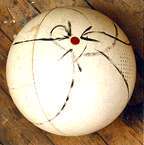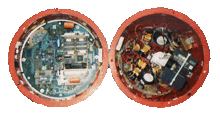Adelbrecht

Adelbrecht was a speaking, interactive robot in the form of a ball, designed by Martin Spanjaard (born 1952 in Haarlem, Netherlands).
A first, simple version of Adelbrecht was presented in 1985. Spanjaard chose the name 'Adelbrecht' because to him it had the connotation of 'stupid' and 'stubborn', which described the character the robot would display. Starting 1988, a second, more powerful version was developed. The successor was able to detect several different 'situations': rolling, bumping, being stuck, being petted etc. Moreover, Adelbrecht was now capable of displaying different states of nature: sleep or awake. Combined with variables nicknamed 'lust' and 'fatigue', the situations and states of nature enabled Adelbrecht to interact with, and respond to its immediate and past environment. In 1992 Adelbrecht received an honourable mentioning at the Prix Ars Electronica. Its last performance, planned at new years eve 2000, never took place because of serious hardware failure. From then on, Spanjaard proclaimed Adelbrecht a 'dead robot'.


Etymology
The name "Adelbrecht" consists of two Middle Dutch words, Adel (Good) and Brecht (Nice). Modern versions of this name are Albert or Elbert.
See also
References
- Wilson, Stephen (2002). Information Arts: Intersections of Art, Science, and Technology. MIT Press. pp. 449–450. ISBN 0-262-73158-4.
- Dunne, Anthony (2005). Hertzian Tales: Electronic Products, Aesthetic Experience, and Critical Design. MIT Press. ISBN 0-262-04232-0.
External links
- Article by Francisco van Jole in the Dutch magazine Blvd (1994)
- Article by Dirk van Weelden in Mediamatic
- Article about Atos Origin on the Dutch Wikipedia
- Ars Electronica Linz, Honorable mentioning (1992)
- Page about Adelbrecht in the Catalogue of the NIMK (Netherlands Media Art Institute)
- Short bio of Martin Spanjaard at V2, Institute of the unstable media, the Netherlands
- Video registration at YouTube (3'40")